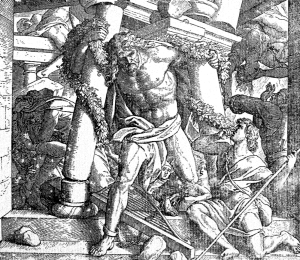 Among the Judges Samson was the one most renowned for his wonderful strength. He was raised up by God to save the Israelites from the Philistines.
Among the Judges Samson was the one most renowned for his wonderful strength. He was raised up by God to save the Israelites from the Philistines. Among the Judges Samson was the one most renowned for his wonderful strength. He was raised up by God to save the Israelites from the Philistines.
Among the Judges Samson was the one most renowned for his wonderful strength. He was raised up by God to save the Israelites from the Philistines.
Once, when still a young man, Samson met a raging lion. He tore the lion to pieces without using any weapon.
In a battle with the Philistines, he killed a thousand men with the jaw-bone of an ass. Another time the Philistines heard that Samson had gone to Gaza. They locked the city gates, so that they might capture him in the morning. At midnight Samson rose. lifted the gates on his shoulders, and carried them with the posts and bolts to the top of a neighboring hill.
Samson married a Philistine woman called Dalila. The Philistines offered to give her money if she would find out wherein his strength lay and how they could overcome him. She agreed to betray Samson.
Dalila begged Samson to reveal the secret to her, but he refused. However, she gave him no rest, and at last he said, "A razor has never passed over my head, for I am consecrated to God. If my head should be shaved, my strength would leave me, I should become weak like other men."
When Samson was asleep, Dalila had his seven locks cut off. His strength left him. The Philistines seized him, put out his eyes, and cast him into prison. But Samson's hair began to grow again.
One day, the Philistines were feasting in their temple. They had Samson brought before them, so that they might make fun of him. About three thousand persons were present.
Samson said to the little boy that led him, "Let me touch the pillars which support the whole house, and let me lean against them, to rest myself a little."
Then he prayed, "O Lord God, restore to me my former strength!" And grasping the two pillars, he shook them violently. The whole building fell, killing Samson and the three thousand Philistines present.
Dalila was the cause of Samson's ruin. She was a bad companion for him. We must keep away from bad companions so that we may not be ruined forever.
- from My Bible History in Pictures, by Bishop Louis LaRavoire Morrow, D.D., 1934; it has the Imprimatur of Archbishop Michael J O'Doherty of Manila, Philippines